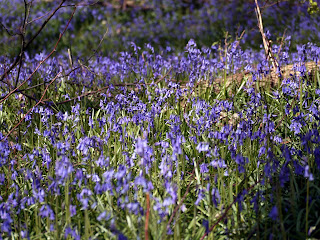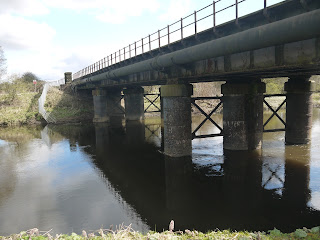 |
| Winston |
Rather randomly my daughter had an inset day on a Tuesday and faced with a beautiful day and at the height of bluebell season we decided to head off and find ourselves a good wood. I had a mind to go to Emmetts Garden in Kent as we had never previously visited. That meant that the best walk for us to do in the area was number 5 in Pathfinder Guide volume 8 Kent Walks. My wife and I actually bought the book when we lived in Kent and it was the first time it has been off the shelf in 15 years!
 |
| Westerham Pond |
Westerham is indelibly linked with Winston Churchill although it was also home to General James Wolfe too. Both men are commemorated with statues in the town, with Wolfe brandishing a sword while Churchill languidly sits on a bench in the middle of the green. This was the official starting point for our walk having wandered the short distance from the long stay car park on the edge of town.
 |
| View Across to North Downs |
We didn't stay long in the heart of town for our path took us down an alley opposite the green and before we new it we were out in the countryside beyond. It was a sunny day with plenty of puffy clouds lumbering across the sky. I did wonder whether they would eventually cover the sun entirely but they never did thankfully. There was still a chill in the air - summer has definitely not quite arrived yet! However it was that magical time of year when the leaves just start turning from buds into full blown foliage, the colour of the new growth is such a treat every year. In the backs of the gardens of Westerham there were also a few blousy looking cherry trees sporting their pink and white blossom. This is equally short lived and has to be appreciated while it lasts.
 |
| Bluebells |
We walked along the side of a field at the back of Westerham houses and as we did we caught sight of a jay - it has been quite a while since I've seen one and for my daughter it was the first time ever. She thought I was pulling her leg when I told her that it was a member of the crow family. To be honest I can see why she was so incredulous - they do look like crows wearing fancy dress!
 |
| Laying Down |
Soon we came upon a small lake that looked for all the world that it might once have been attached to a mill. Now just a green oasis we enjoyed the antics of the ducks briefly before moving on past the rather attractive lodge house announcing the start of Squerryes Park. The house at the centre of the park seemed to be out of sight, rather hidden by some trees. The house itself is no longer open to the public so looks like we have missed our chance at least for the time being.
 |
| Tower Wood |
The walk across the park was delightful, with views back towards the scarp slopes of the North Downs. I think we might well be tempted to tackle that walk as a family in the not too distant future. Long time readers of my blog will know that I started the walk in 2004 and walked all of the Surrey stretch before running out of steam at Otford almost in sight from this location. The path was quite obviously heading uphill as we climbed the slopes of the Greensand ridge just to the south of the North Downs. For my money the Greensand Way was a far superior path to the North Downs Way, probably because it is much quieter and not spoiled by the roar of traffic from the M25/ M20.
 |
| Fresh New Growth |
Eventually we came to the woods and the bluebells didn't disappoint - thick blue carpets everywhere and we seemed to catch them at their zenith. We stood and stared for a while enjoying the spread, feeling very lucky that we had the while place to ourselves. As we headed onwards we passed a field full of cows all laying down - hopefully not a sign of things to come?
 |
| Picnic Area |
Our path headed further and further into the woods. We came upon a section that was cleared but otherwise it got denser and denser and we felt that we were firmly in fairy tale country. In truth the woodland was so densely packed it made me feel slightly uncomfortable. I was pleased then when we joined the Greensand Way proper for I knew that we would soon see views out from the ridge. As we got to Mariners Wood we passed a rather strange and random little picnic area. It looked like it had been left as unwanted furniture from the neighbouring property yet you could not describe it as fly-tipped as it was set out nicely. I wonder how many passing walkers avail themselves of the facility?
 |
| Mariners Hill View |
The view from Mariners Hill is quite special. I paused for a time looking out over the Weald from here - the brooding clouds added a certain menace to the scene but here and there shafts of sunlight lit up small patches of countryside. We dropped down from the top of the ridge to the estate of Chartwell below heading down through more exquisite bluebell lined paths as we did. The next part of the walk was less appealing - we had to pass by Chartwell along a very busy road (the one bringing the shedloads of visitors in!) Lucky for me that I had no sense of smell (courtesy of a cold) for my daughter reported that the aromas from the visitor cafe were very appealing!
 |
| Chartwell |
Chartwell was of course the home of Winston Churchill and as a result is probably one of the most visited of any National Trust properties. It is a great place to look around but we decided that it ought to be a family trip rather than just the two of us and so we continued on our way, turning left and off the road as we got to the end of the car park. What followed was a very hemmed in path and one which was pretty muddy, an unusual section for this walk. This continued all the way over to the hamlet of French Street. I remembered this part of the Greensand Way for the lovely blooms on the rhododendrons and was pleased to see some were out as we reached the hamlet.
 |
| French Street |
We dog legged around the scattering of houses and the rather unusual burial ground in the middle dominated by a very large yew tree (isn't there always a yew tree in such places?). Our path almost seemed to double back on itself, albeit at a slightly higher level. We descended into the forest again and the feeling of loneliness returned. I think my senses were heightened by the fact that my daughter was with me. Probably a good job that there are no dangerous wild animals in the UK for if there were this is exactly the sort of place I might find them! It wasn't all unpleasant though - the siging birds were a joy to listen to.
 |
| Burial Yard |
Eventually we emerged from the woods onto a main road at Hosey Hill and passed an old school. I was slightly disorientated here but soon found the path on the opposite side of the road. From here our way back to Westerham got a bit confusing. Not quite sure how we did it but we found our way back to the lodge house that we had passed at the beginning of the walk even though we were supposed to meet our original path at the end of the alley into Westerham. No matter - it added only a little bit to our journey and we managed to get back while still in sunshine. Over the North Downs was the blackest cloud I have seen for some time - we managed to get back to the car without getting wet, quite a result!
 |
| Westerham |
This short walk is a good one for bluebells (and other spring flowers for that matter) and could easily be used as an opportunity to explore Quebec House (home of General Wolfe) and Chartwell (home of Churchill). I could imagine this walk could then be an all day affair. As it was it took us a little over two hours - just about perfect before heading to Emmetts Garden nearby for a welcome tea.



















